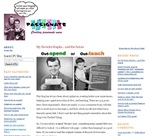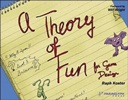The Inspiration Bookshelf: The Best Books for Design, Learning and User Experience
When people ask me how long it took to write my book, I tell them “Either nine months, or ten years, depending on how you look at it.”
I don’t think I’m the first person to find that writing a book (particularly a first book) requires a long period of mulling, sifting, curating and discarding before you actually sit down and commit to all that thinking and learning and processing to paper.
One of the things I had while writing my book was an inspiration bookshelf. These were books that not only inspired the content of Design for How People Learn, but also the style of it. These are the books that were special, not only in the content, but also in the way that they were written and designed.
I also tend to think that people with an interest in any kind of design should have many of these books on their own shelves, in all their cracked-spine, dog-eared, notes-in-the-margin glory. Your design library may also have other books (maybe Tufte or Lidwell et al). I don’t pretend that this is a complete design library, but I do think these are some of the essentials.
 The Design of Everyday Things by Donald Norman
The Design of Everyday Things by Donald Norman
I very clearly remember reading the Design of Everyday Things and feeling like my head had been picked up and put back on 90 degrees to the left, and that the way I looked at the world had been permanently altered.
I learned about affordances, embedded knowledge and desire paths. I learned never to look at a door handle the same way ever again. I started to have just an inkling of what it meant to look at the world with the eye of a designer.
More than that, I learned about taking complicated ideas about cognitive science and human factors and the psychology of behavior and making them easy to understand through conversational, clear explanations, and--much more importantly--through stories and visuals.
You can read extensive research about cognitive load and embedded cognition, or you can read a story about Don Norman’s stove top. Which do you think you’ll remember months or years later?
The Non-Designer’s Design Book by Robin Williams
When I wrote my book, the book I wanted it most to be like was The Non-Designer’s Design Book.
I don’t necessarily mean that I wanted it to be exactly like in format or even style (though those are worthy aspirations).
What I really wanted was for my book to be the book that my professional colleagues would hand to their friend, family member, or co-worker, saying, “You need to know about learning design? Here’s the book you should start with.”
The Non-Designer’s Design Book is that book for graphic design. It’s the book you know anyone can pick up and read and understand and get value from with no background in the subject area at all. Taking something that you know at an expert level and explaining it at a level that anyone can understand is incredibly hard, and Robin Williams does it beautifully.
Don’t Make Me Think by Steve Krug
Don’t Make Me Think is subtitled “A Common Sense Approach to Web Usability” and it is. But it’s also a way into understanding the importance of usable design for any medium and of testing those designs with users.
I’ve probably given away more copies of Don’t Make Me Think than any other book, because it’s the fastest way to get people on board with the concepts of usability and user testing, and it helps people understand why, as designers, we should spend much less time getting information on the audience’s opinions, and much more on understanding and observing their behaviors.
I also said that I wanted to create a really accessible, visual book, and Don’t Make Me Think was one of the models I looked to for how it used visuals and humor and conversational tone to create an incredible accessible, usable book.
 Understanding Comics by Scott McCloud
Understanding Comics by Scott McCloud
There are a lot of wonderful things you can learn about design from Understanding Comics that apply even if you never make a single comic in your life.
You can learn about visual storytelling, and communicating without words, and about abstract vs. concrete representation. You can learn about human perception, and about showing transitions of time, motion and place.
Another fantastic thing you can learn about from Understanding Comics is the lesson of Eating Your Own Dogfood.
If you aren’t familiar with the book, you might not know that not only is it a book about comics, it is a comic. The entire book is written as a comic book about how comics work.
This was a really important lesson for me – I wanted to write a book about learning design, and education classes are rife with people violating the dogfood rule. I’ve read unbearably tedious texts all about the need to intrinsically motivate students, and I’ve listened to 90-minute lectures on the importance of active student participation in learning. “Do as I say, not as I do” is endemic in education classes, and I wanted to avoid it as much as I possibly could.
Understanding Comics is one of the books that I kept on the inspiration bookshelf to remind me that it is possible to create something that uses its own medium to communicate, and inhabits that medium completely.
 Creating Passionate Users by Kathy Sierra
Creating Passionate Users by Kathy Sierra
I first became aware of Kathy Sierra via her 2004-2007 blog called Creating Passionate Users. You can’t literally put a blog on a bookshelf, so I had to compromise and put a copy of Head First Statistics on the shelf instead.
I’m pretty sure that I learned more about design from reading her blog than I did from two years in graduate school.
One of the key lessons was the idea that good design wasn’t about proving how awesome I was, or how awesome the design was. Good design was about proving how awesome the end user was. You didn’t succeed by making a great product – you succeeded by helping the person using that product to be great.

 A Theory of Fun for Game Design by Raph Koster and The Art of Game Design by Jesse Schell
A Theory of Fun for Game Design by Raph Koster and The Art of Game Design by Jesse Schell
I’m putting these two books together because they are both game design books, and learning about game design has transformed the way I think about design as a whole, and specifically learning design.
Games are ferocious engines of learning – there isn’t a game that exists that doesn’t reward the triumph of learning, and really well-designed games are all about developing cycles of expertise and about improving your skill level and performance. As Raph Koster puts it, “Fun is just another word for learning.”
 Orbiting the Giant Hairball by Gordon MacKenzie
Orbiting the Giant Hairball by Gordon MacKenzie
The subtitle of Orbiting the Giant Hairball is “A Corporate Fool’s Guide to Surviving with Grace” and it’s ostensibly a business book.
What it is really is a book about maintaining your creativity in the face of all the things that threaten it – timelines and budgets and administrative procedures and analytics, and regressing to the norm.
From this book I learned that creativity should be protected, imperfection can be beautiful, and that you can (and probably should) doodle in the margins.
More Inspiration
Some honorable mentions that probably should have been on the bookshelf but weren’t, mostly because I didn’t read them until later, include:
- Seductive Interaction Design by Stephen Anderson – Stephen Anderson looks at the importance of design in creating delight, allure and seduction. Along with Donald Norman’s Emotional Design, it’s one of the most compelling arguments for the importance of design that is delightful as well as functional.
- Presentation Zen by Garr Reynolds – This was one of the first books that I encountered that really communicated how and why visuals are powerful conveyers of message.
- Resonate by Nancy Duarte – This book is lovely piece of design in itself, and it has really interesting things to say about how to create a messages, stories, and calls to action.
- The Back of the Napkin by Dan Roam – When I was trying to figure out if I could afford an illustrator for my own book, I learned from both Dan Roam and from XKCD.com Comics that I could create my own visuals for communicating ideas, and that stick figures were just fine.
Summary
These are some of the books on my inspiration bookshelf. These books are special, not only in the content, but also in the way that they are written and designed. When you read them, you learn from what the author is saying, and you learn just as much from how the author is saying it, and also from how the whole experience of how the book is designed. What’s on your inspiration bookshelf?